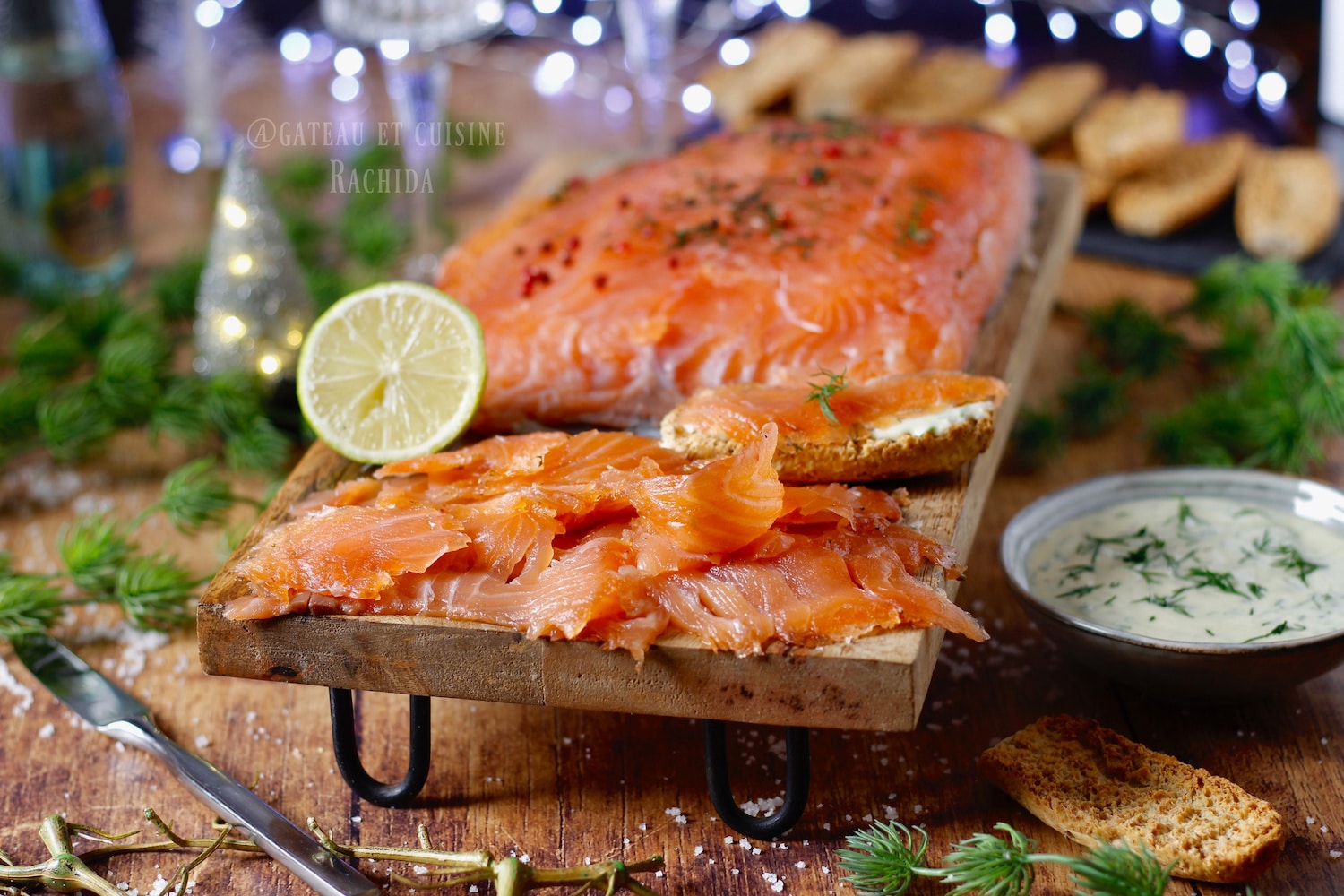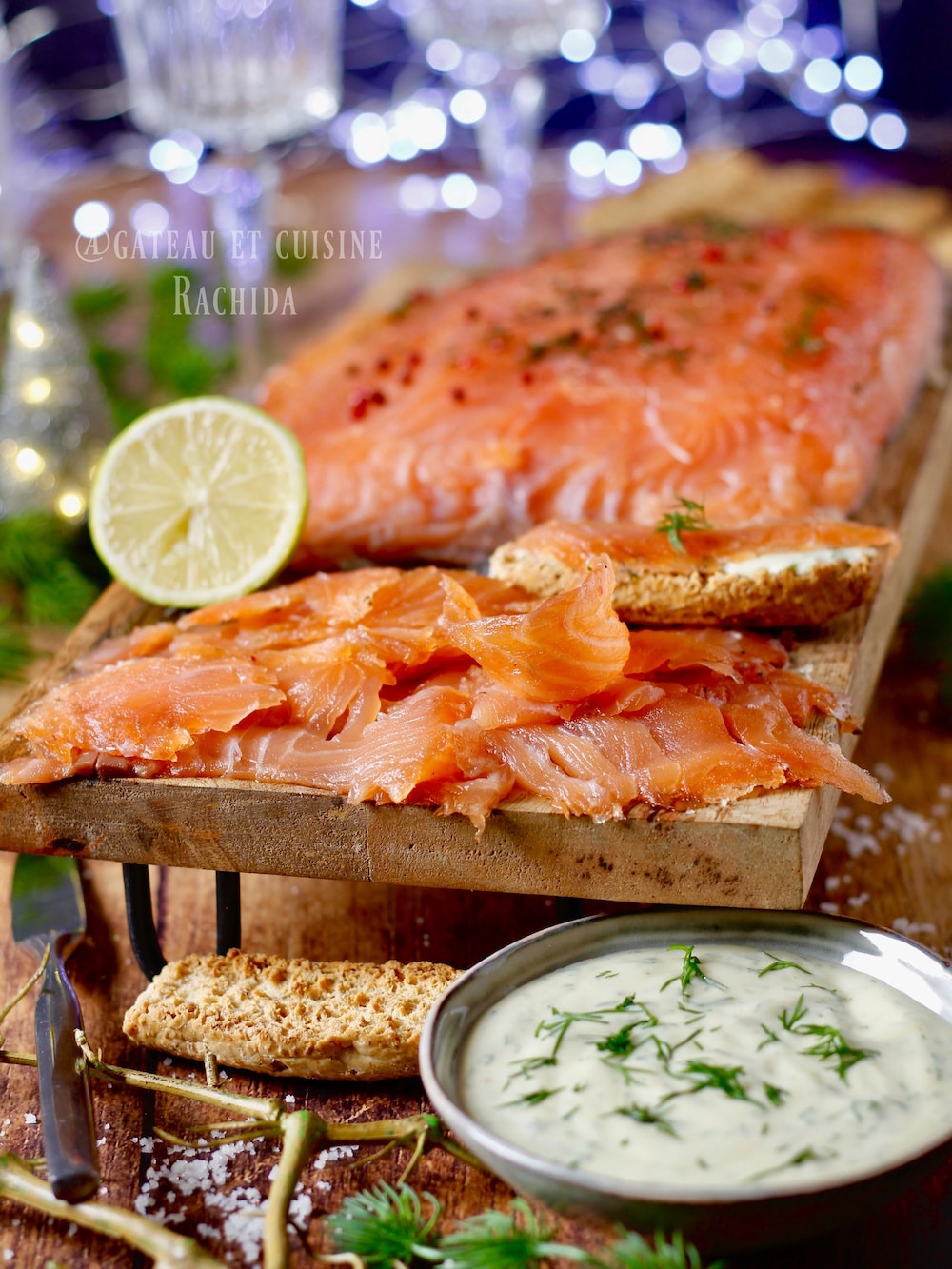
Salmon gravlax , or gravad laks in Swedish, literally “buried salmon”, is a traditional Scandinavian recipe that has become a staple on festive tables, especially at Christmas and New Year’s. Homemade salmon gravlax with dill sauce is always a hit as an appetizer or for a dinner party. It charms with its refined flavor and delicate texture, both firm and melt-in-the-mouth.
Similar in appearance and texture to smoked salmon, gravlax differs in its preparation: there’s no smoking involved, only gentle cold curing. A high-quality raw salmon fillet (ideally wild) is used, covered with a mixture of salt, sugar, dill, and spices such as black pepper, pink peppercorns, or juniper berries. The fillet is then tightly wrapped and placed under light pressure to draw out excess moisture. This process gently “cures” the fish without any heat.

After resting for 1 to 3 days in the fridge, the fillet is rinsed and finely sliced. It’s typically served on canapés or toast, accompanied by the classic Swedish dill and Dijon mustard sauce.
Fish lovers will be won over by this elegant dish, as delicious as it is convivial. Preparing it yourself, using high-quality ingredients, makes the experience even more enjoyable to share.

Table of Contents
Ingredients:
NB: You’ll find the printable recipe card at the end of this article.
For the cured salmon gravlax
- 800 g to 1 kg raw salmon fillet, skin on and pin bones removed
- 250 g coarse sea salt (preferably Guérande salt; fine salt works too, but the gravlax will be saltier)
- 250 g granulated sugar
- 1 large bunch of fresh dill
- 1 tablespoon pink peppercorns
- 1 tablespoon mixed peppercorns (e.g. Ducros “5 berries” or a blend of black, white, Timut, and Sichuan pepper with coriander seeds)
- 1 tablespoon fennel seeds
- Zest of a lemon or orange (optional, to add a subtle citrus note to the cure)
For the Dill Sauce
- 1 plain yogurt
- 1 teaspoon mustard
- Juice of half a lemon
- 1 teaspoon olive oil
- 1 teaspoon honey (more or less, to taste)
- Chopped fresh dill, to taste
- Salt and pepper
Ingredient Tips
Salmon: Choose a fresh fillet with the skin on, ideally wild-caught. Let your fishmonger know you’re preparing gravlax so they can remove the pin bones.
For 6 to 8 servings, plan on 800 g to 1 kg of salmon.
Important: Freeze the salmon for at least 24 hours before use to eliminate any risk of parasites. Defrost it slowly in the refrigerator.
Salt and Sugar: These are essential for cold curing the fish. Use coarse sea salt if possible, and always in equal parts with sugar.
As a general rule, the total weight of salt + sugar should be around half the weight of the salmon.
Do not go below 10% salt relative to the weight of the fish.
Note : Some recipes use very little salt, which can lead to uneven curing. In some areas, the salt concentration may be too low to prevent bacterial growth. Always make sure to use enough salt to ensure safe and effective curing.

Preparation steps :
Rinse the salmon fillet under cold running water, drain, and pat it dry thoroughly with paper towels.
Place it on a cutting board and check that all the pin bones have been removed by the fishmonger. If not, you can remove them using tweezers.
Using a mortar and pestle, coarsely crush the peppercorns, pink peppercorns, and fennel seeds. Finely chop half of the fresh dill.
In a bowl, mix the salt, sugar, chopped dill, and crushed spices to create the curing mixture.
In a baking dish large enough to hold the entire salmon fillet, spread a layer of the salt, sugar, and spice mix. Add a bit more around the edges, this will help cover the sides of the fish.

Cover the flesh side of the salmon completely with fresh dill sprigs, then gently place the fillet flesh-side down onto the salt mixture.
Bring the salt mixture up around the sides to ensure the entire fillet is well covered. Wrap tightly in 2 to 3 layers of plastic wrap, pressing it directly against the fish.
Place a dish or tray on top of the wrapped salmon along its full length, then add a weight to apply gentle pressure. Refrigerate for 24 to 72 hours (1 to 3 days), depending on the thickness of the fillet. I left mine for 48 hours.

Each day, drain off the liquid released by the salmon. The fillet will gradually take on a lovely orange hue and become firmer in texture.
The curing time will depend on the thickness of the fillet and the desired level of dryness.
After the second day, remove the salmon from the dish and rinse it briefly under cold running water to remove excess salt.
Place it on paper towels and pat it dry thoroughly on both sides. Then, using a knife, gently scrape off the marinade and dill sprigs.
You can enjoy it immediately, or for an even better texture, let it air-dry uncovered on a rack in the fridge for a few more hours.

Place the salmon gravlax on a serving platter or slice it thinly on the bias, leaving the skin on. Use a sharp knife for best results.
Arrange the slices neatly on a plate, drizzle with a little olive oil, and sprinkle with fresh dill.
I served it whole on a charcuterie board, slicing only part of it beforehand. The rest was sliced at the table. I also sprinkled a few pink peppercorns on top for decoration.
Make the Dill and Mustard Sauce
Mix the yogurt with the mustard, lemon juice, and olive oil. Season with salt and pepper, then add the honey and chopped dill to taste.
Serve the salmon gravlax with the dill sauce and slices of toasted bread or blinis. Whole grain Swedish Krisprolls are also excellent, they’re extra crispy.
This simple recipe lets you prepare delicious homemade salmon gravlax, perfect for delighting your guests at a festive meal or as an appetizer!

How to Serve Salmon Gravlax ?
This fish, similar to smoked salmon, can easily be used as a substitute in any recipe where smoked salmon is typically used.
You can serve the whole fillet on a platter and slice it at the table in front of your guests. Alternatively, slice it thinly and arrange it on a slate board with a few sprigs of dill, presentation is entirely up to your creativity.
Gravlax is often served as an appetizer, accompanied by crispy toasted bread and a sweet (or not) mustard-dill sauce, or with a spoonful of double cream. It’s also perfect served in small glasses with avocado, or on crackers with cream cheese, blinis, canapés, or bruschetta.
How to Store Salmon Gravlax ?
Once prepared, gravlax salmon can be stored in the refrigerator for up to 5 days, tightly wrapped in plastic wrap. For longer storage, vacuum-seal it, and it will keep for up to 10 days. However, it’s best enjoyed fresh.
Reader Tip: One reader shared a clever tip to give gravlax a subtly smoky flavor, without a smoker:
“A perfect recipe I’ve been using ever since I gave up traditional smoking.
One trick I recommend: add a very smoky tea to the curing mix.
(Blind tasting between a deli-bought smoked salmon and my gravlax… barely any difference, except for the cost 😉).”

Cured salmon gravlax with dill sauce
INGREDIENTS
For the gravlax
- 800 g to 1 kg raw salmon fillet skin on and pin bones removed
- 250 g coarse sea salt preferably Guérande salt; fine salt works too, but the gravlax will be saltier
- 250 g granulated sugar
- 1 large bunch of fresh dill
- 1 tablespoon pink peppercorns
- 1 tablespoon mixed peppercorns e.g. Ducros "5 berries" or a blend of black, white, Timut, and Sichuan pepper with coriander seeds
- 1 tablespoon fennel seeds
- Zest of a lemon or orange optional, to add a subtle citrus note to the cure
For the Dill Sauce
- 1 plain yogurt
- 1 teaspoon mustard
- Juice of half a lemon
- 1 teaspoon olive oil
- 1 teaspoon honey more or less, to taste
- Chopped fresh dill to taste
- Salt and pepper
PREPARATION
Prepare the gravlax
- Rinse the salmon fillet under cold running water, drain, and pat it dry thoroughly with paper towels.
- Place it on a cutting board and check that all the pin bones have been removed by the fishmonger. If not, you can remove them using tweezers.
- Using a mortar and pestle, coarsely crush the peppercorns, pink peppercorns, and fennel seeds. Finely chop half of the fresh dill.
- In a bowl, mix the salt, sugar, chopped dill, and crushed spices to create the curing mixture.
- In a baking dish large enough to hold the entire salmon fillet, spread a layer of the salt, sugar, and spice mix. Add a bit more around the edges, this will help cover the sides of the fish.
- Cover the flesh side of the salmon completely with fresh dill sprigs, then gently place the fillet flesh-side down onto the salt mixture.
- Bring the salt mixture up around the sides to ensure the entire fillet is well covered. Wrap tightly in 2 to 3 layers of plastic wrap, pressing it directly against the fish.
- Place a dish or tray on top of the wrapped salmon along its full length, then add a weight to apply gentle pressure. Refrigerate for 24 to 72 hours (1 to 3 days), depending on the thickness of the fillet. I left mine for 48 hours.
- Each day, drain off the liquid released by the salmon. The fillet will gradually take on a lovely orange hue and become firmer in texture.
- The curing time will depend on the thickness of the fillet and the desired level of dryness.
- After the second day, remove the salmon from the dish and rinse it briefly under cold running water to remove excess salt.
- Place it on paper towels and pat it dry thoroughly on both sides. Then, using a knife, gently scrape off the marinade and dill sprigs.
- You can enjoy it immediately, or for an even better texture, let it air-dry uncovered on a rack in the fridge for a few more hours.
- Place the salmon gravlax on a serving platter or slice it thinly on the bias, leaving the skin on. Use a sharp knife for best results.
- Arrange the slices neatly on a plate, drizzle with a little olive oil, and sprinkle with fresh dill.
- I served it whole on a charcuterie board, slicing only part of it beforehand. The rest was sliced at the table. I also sprinkled a few pink peppercorns on top for decoration.
Make the Dill and Mustard Sauce
- Mix the yogurt with the mustard, lemon juice, and olive oil. Season with salt and pepper, then add the honey and chopped dill to taste.
- Serve the salmon gravlax with the dill sauce and slices of toasted bread or blinis. Whole grain Swedish Krisprolls are also excellent, they’re extra crispy.
- This simple recipe lets you prepare delicious homemade salmon gravlax, perfect for delighting your guests at a festive meal or as an appetizer!
Thank you for your visit and your comments
